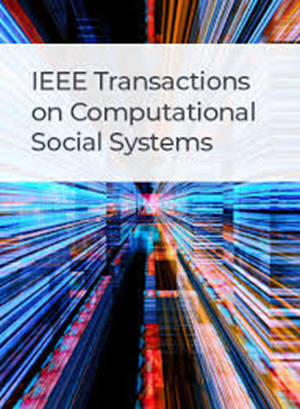Unveiling Agents’ Confidence in Opinion Dynamics Models via Graph Neural Networks
IF 4.5
2区 计算机科学
Q1 COMPUTER SCIENCE, CYBERNETICS
IEEE Transactions on Computational Social Systems
Pub Date : 2024-12-11
DOI:10.1109/TCSS.2024.3508452
引用次数: 0
Abstract
Opinion Dynamics models in social networks are a valuable tool to study how opinions evolve within a population. However, these models often rely on agent-level parameters that are difficult to measure in a real population. This is the case of the confidence threshold in opinion dynamics models based on bounded confidence, where agents are only influenced by other agents having a similar opinion (given by this confidence threshold). Consequently, a common practice is to apply a universal threshold to the entire population and calibrate its value to match observed real-world data, despite being an unrealistic assumption. In this work, we propose an alternative approach using graph neural networks to infer agent-level confidence thresholds in the opinion dynamics of the Hegselmann-Krause model of bounded confidence. This eliminates the need for additional simulations when faced with new case studies. To this end, we construct a comprehensive synthetic training dataset that includes different network topologies and configurations of thresholds and opinions. Through multiple training runs utilizing different architectures, we identify GraphSAGE as the most effective solution, achieving a coefficient of determination基于图神经网络的意见动态模型中主体信心的揭示
社交网络中的意见动态模型是研究意见在人群中如何演变的一个有价值的工具。然而,这些模型通常依赖于难以在实际人口中测量的代理级参数。这是基于有限置信度的意见动态模型中的置信阈值的情况,其中代理只受到具有类似意见的其他代理的影响(由该置信阈值给出)。因此,一种常见的做法是对整个人口应用一个通用阈值,并校准其值以匹配观察到的真实世界数据,尽管这是一个不切实际的假设。在这项工作中,我们提出了一种替代方法,使用图神经网络来推断Hegselmann-Krause有界置信模型的意见动态中的代理级置信阈值。这消除了在面对新的案例研究时进行额外模拟的需要。为此,我们构建了一个全面的综合训练数据集,其中包括不同的网络拓扑结构和阈值和意见的配置。通过使用不同架构的多次训练运行,我们确定GraphSAGE是最有效的解决方案,在来自现实世界拓扑的测试数据集中实现了高于0.7的决定系数R^{2}$。值得注意的是,即使测试拓扑的大小与训练期间考虑的拓扑不同,这种性能也保持不变。
本文章由计算机程序翻译,如有差异,请以英文原文为准。
求助全文
约1分钟内获得全文
求助全文
来源期刊

IEEE Transactions on Computational Social Systems
Social Sciences-Social Sciences (miscellaneous)
CiteScore
10.00
自引率
20.00%
发文量
316
期刊介绍:
IEEE Transactions on Computational Social Systems focuses on such topics as modeling, simulation, analysis and understanding of social systems from the quantitative and/or computational perspective. "Systems" include man-man, man-machine and machine-machine organizations and adversarial situations as well as social media structures and their dynamics. More specifically, the proposed transactions publishes articles on modeling the dynamics of social systems, methodologies for incorporating and representing socio-cultural and behavioral aspects in computational modeling, analysis of social system behavior and structure, and paradigms for social systems modeling and simulation. The journal also features articles on social network dynamics, social intelligence and cognition, social systems design and architectures, socio-cultural modeling and representation, and computational behavior modeling, and their applications.
 求助内容:
求助内容: 应助结果提醒方式:
应助结果提醒方式:


